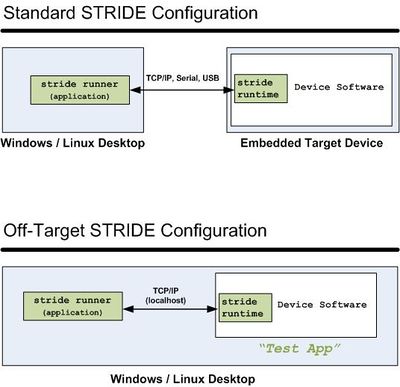STRIDE Off-Target Environment
Configuration
Two of the largest barriers to embedded developer productivity are long build/test cycles and scarce target hardware. Fortunately, STRIDE's cross-platform capabilities make it possible to run STRIDE in a host-only Off-Target Configuration that emulates your target system.
In order to conduct training or build and execute our Samples, we leverage this environment (i.e. single Windows or Linux (x86) computer for both the target and host systems). Host and target code will run in separate processes and communicate via TCP/IP, thus simulating an embedded target with host computer configuration. All code and techniques used in the Off-Target Environment are directly transferable to a production environment. This enables the user to create their own sandbox for training and Off-Target unit testing.
The Off-Target Environment utilizes the Framework's "SDK" that can be built and executed on the host system. When using the SDK Makefile a simulated target native application is generated, which we call a Test Application (TestApp).
The STRIDE Runner application executes on the same system and communicates with the TestApp process over a TCP/IP connection. This setup frees you from external hardware dependencies and provides for a rapid "edit/build/test" cycle.
Host Compiler
The off-target environment requires a STRIDE Desktop Installation, and the appropriate host compiler:
- For Windows, Microsoft Visual Studio 2008 or later is required. If you don't already have Visual Studio, the free Visual C++ Express can be used (download here). In case you have Cygwin installed, the GNU Compiler Collection could be used as an alternative.
- For Linux and FreeBSD, the GNU Compiler Collection (included by default in almost all distros) is required.
For instructions on building an off-target TestApp refer to the following article.
